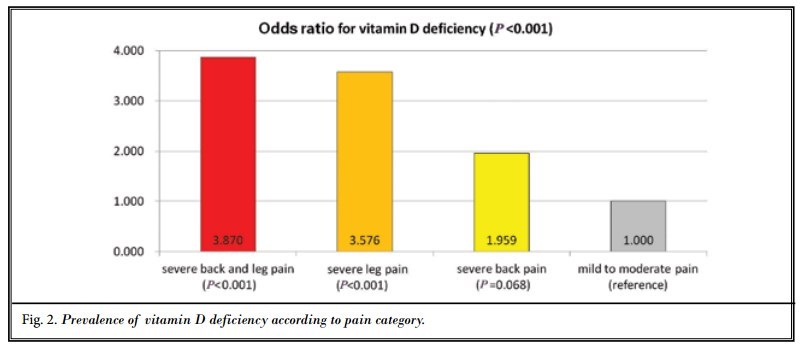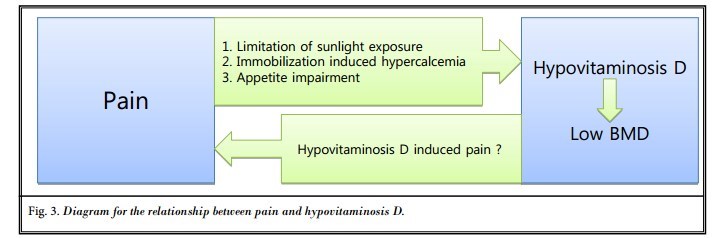Back pain extremely associated with low level of vitamin D
Assessment of Vitamin D status In Patients of Chronic Low Back Pain of Unknown Etiology
Indian Journal of Clinical Biochemistry, May 2014
Moushumi Lodh, Binita Goswami, Rajni Dawar Mahajan, Dipankar Sen, Nirmal Jajodia, Abhishek Roy
Low back pain is very disabling and dispiriting because of the physical impediment it causes and its psychological effects. Innumerable factors have been implicated in its etiology. In spite of improvements in diagnostic modalities, a considerable number of such cases fall in the ambiguous zone of unknown etiology or ‘idiopathic.’Early diagnosis of low back pain will allow effective prevention and treatment to be offered. This study was conducted to assess the contribution of vitamin D levels and other biochemical factors to chronic low back pain in such cases.
All patients attending the orthopedics OPD for low back pain in whom a precise anatomical cause could not be localized, were prospectively enrolled in this study. We measured serum levels of
glucose,
calcium,
phosphorus,
uric acid,
rheumatoid factor,
C reactive protein,
alkaline phosphatase,
total protein,
albumin and
25 (OH) D concentrations
in 200 cases and 200 control samples.
The patients showed significantly lower vitamin D levels compared to controls with p value < 0.0001. The maximum number of low back pain patients were in the age group of 31–50 years (42 %).The average BMI was 23.27 ± 5.17 kg/sq m, 73 % of total patient population were females and 27 % were known case of type 2 diabetes mellitus.
th care providers. The problem in developing countries is compounded by ignorance to report for early treatment and occupational compulsions in rural areas and sedentary lifestyle in urban youth. The authors strongly recommend early frequent screening for vitamin D along with glucose, protein, albumin, calcium, phosphorus, CRP as part of general health checkup for non-specific body pain, especially low back pain.
📄 Download the PDF from VitaminDWiki
Prevalence of vitamin D deficiency in patients with lumbar spinal stenosis and its relationship with pain.
Pain Physician. 2013 Mar-Apr;16(2):165-76.
Kim TH1, Lee BH, Lee HM, Lee SH, Park JO, Kim HS, Kim SW, Moon SH.
BACKGROUND:
Patients with lumbar spinal stenosis (LSS) are at a great risk of a fall and fracture, which vitamin D protects against. Vitamin D deficiency is expected to be highly prevalent in LSS patient, and pain is thought to have a profound effect on vitamin D status by limiting activity and sunlight exposure.
OBJECTIVE:
To identify the prevalence of vitamin D deficiency (serum 25-hydroxyvitamin D [25-OHD] < 20ng/mL) and its relationship with pain.
STUDY DESIGN:
Nonblinded, cross-sectional clinical study.
SETTING:
University-based outpatient clinic of the Department of Orthopedic Surgery, Yonsei University College of Medicine, Korea.
METHODS:
Consecutive patients who visited the orthopedic outpatient clinic for chronic low back pain and leg pain and were diagnosed as LSS between May 2012 and October 2012 were included. Pain was categorized into 4 groups based on location and severity: 1) mild to moderate back or leg pain; 2) severe back pain; 3) severe leg pain; and 4) severe back and leg pain. Covariates for vitamin D deficiency included age, sex, body mass index, level of education, medical history, season, region of residence, sunlight exposure score and functional disability. 25-OHD level was measured by radioimmunoassay, and bone metabolic status including bone mineral density and bone turnover markers was also measured. Multivariable logistic regression modeling was used to adjust all risk estimates for covariates.
RESULTS:
The study had 350 patients enrolled. Mean serum 25-OHD level was 15.9 ± 7.1 ng/mL (range, 2.5 ~ 36.6). of the 350 patients, 260 patients out of 350 (74.3%) were vitamin D deficient. Univariate logistic regression analysis showed a significantly higher prevalence of vitamin D deficiency in the following patients: 1) medical comorbidity; 2) urban residence rather than rural; 3) lower score for sunlight exposure; and 4) severe leg pain, or severe back and leg pain rather than mild to moderate pain. Pain category was significantly associated with lower sunlight exposure; however, the association between pain category and vitamin D deficiency remained significant even after adjustment for the sunlight exposure. Furthermore, severe back pain, and severe back and leg pain were also associated with higher incidence of osteoporosis and higher level of bone resorption marker (serum CTx).
LIMITATIONS:
The limitation of our study is that due to its cross-sectional design, causal relationships between pain and vitamin D deficiency could not be established.
CONCLUSION:
Vitamin D deficiency was highly prevalent in LSS patients (74.3%), and severe pain was associated with higher prevalence of vitamin D deficiency and osteoporosis which could be potential risk factors or a fall and fracture. As evidenced by the present study, assessment of serum 25-OHD and bone mineral density are recommended in LSS patients with severe pain, and active treatment combining vitamin D, calcium, or bisphosphonate should be considered according to the status of the bone metabolism.
PMID: 2351168


PDF is attached at the bottom of this page
Women Were 2.4 X more lifely to have nonspecific low back pain if low vitamin D
Vitamin D deficiency is associated with nonspecific low back pain in young women, a case-control study.
Authors
Heidari, B.; Javadian, Y.; Heidari, P.; Hakimi, N.; Hajian-Tilaki, K.; Firouzjahi, A. R.
British Journal of Medicine and Medical Research 2014 Vol. 4 No. 31 pp. 5053-5061
ISSN 2231-0614; DOI 10.9734/BJMMR/2014/11309
URL http://www.sciencedomain.org/abstract.php?iid=590&...
Record Number
20143261884
Abstract
Background: Vitamin D deficiency is linked to several musculoskeletal conditions including nonspecific low back pain, autoimmune diseases. Data regarding to vitamin D deficiency and low back pain are not consistent across various studies. The objective of this case-control study was to determine association of vitamin D deficiency and low back pain in women. Methods: Eighty-one women with nonspecific low back pain and 101 age-matched controls entered the study. Serum vitamin D was assessed by quantitative determination of serum 25-hydroxyvitamin D (25-OHD) by electerochemiluminecence method, and levels <20 ng/ml were considered as vitamin D deficiency. Mann-Whitney U test and chi square test was used for analysis. Results: Mean age of patients and controls was 35.1±8.14 and 37.4±7.9 years respectively. Median serum 25-OHD concentration in patients was significantly lower than control group (p=0.003). Serum 25-OHD deficiency was observed in 57(70.4%) patients versus 47(46.5%) controls (p=0.001). There was a significant association between serum 25-OHD deficiency and low back pain (OR=2.72, 95%CI, 1.47-5, p=0.001). 25-OHD deficiency was significantly correlated with low back pain (r=0.239, p=0.001). Conclusion: This study indicates a significant association between vitamin D deficiency and nonspecific LBP in women and justifies serum 25-OHD assessment in women with low back pain.
See also VitaminDWiki
Vitamin D Receptor gene relationship to lower back pain – study funded June 2013
Back pain associated with less than 40 ng vitamin D – March 2013
Back pain reduced for 95 % of those who took vitamin D - 2003 file, not web page
- "only" 95% of the people with back pain were helped with vitamin D 5000 IU or 10,000 IU daily
- This one article was the vitamin D trigger for admin of VitaminDWiki and many others, such as the following author
- Back pain cured with vitamin D – Book May 2014
